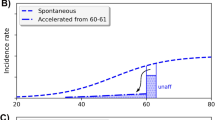Abstract
In his Nobel Prize Lecture of December 12, 1946, Hermann J. Muller argued that the dose–response for radiation-induced germ cell mutations was linear and that there was “no escape from the conclusion that there is no threshold”. However, assessment of correspondence between Muller and Curt Stern 1 month prior to his Nobel Prize Lecture reveals that Muller knew the results and implications of a recently completed study at the University of Rochester under the direction of Stern, which directly contradicted his Nobel Prize Lecture. This finding is of historical importance since Muller’s Nobel Lecture gained considerable international attention and is a turning point in the acceptance of the linearity model in risk assessment for germ cell mutations and carcinogens.
Similar content being viewed by others
References
American Philosophical Society, Philadelphia (1946/1947a) Curt Stern Papers, Hermann J. Muller File, URL: http://amphilsoc.org
American Philosophical Society, Philadelphia (1946/1947b) Curt Stern Papers, Ernst Caspari File, URL: http://amphilsoc.org
Bolt HM, Marchan R, Hengstler JG (2009) Low-dose extrapolation in toxicology: an old controversy revisited. Arch Toxicol 83:197–198
Calabrese EJ (2009) The road to linearity: why linearity at low doses became the basis for carcinogen risk assessment. Arch Toxicol 83:203–225
Calabrese EJ (2011) Key studies used to support cancer risk assessment questioned. Environ Mol Mut 52 (in press)
Calabrese EJ, Baldwin LA (2003) Toxicology rethinks its central belief. Nature 421:691–692
Carlson EA (1981) Genes, radiation, and society: the life and work of H.J. Muller. Cornell University Press, Ithaca
Caspari E, Stern C (1947) The influence of chronic irradiation with gamma-rays at low dosages on the mutation rate in Drosophila melanogaster. MDDC-1200, US Atomic Energy Commission, pp 1–18. Found on the web at Hathi Trust Digital Library, http://www.hathitrust.org
Caspari E, Stern C (1948) The influence of chronic irradiation with gamma-rays at low dosages on the mutation rate in Drosophila melaogaster. Genetics 33:75–95
Hanson FB, Heys F (1929) An analysis of the effect of the different rays of radium in producing lethal mutations in Drosophila. Am Nat 63:201–213
Hanson FB, Heys F (1932) Radium and lethal mutations in Drosophila further evidence of the proportionality rule from a study of the effects of equivalent doses differently applied. Am Nat 66:335–345
Hoffmann GR (2009) A perspective on the scientific, philosophical, and policy dimensions of hormesis. Dose-Response 7:1–51
Muller HJ (1927) Artificial transmutation of the gene. Science 66:84–87
National Academy of Sciences (1977) Safe drinking Water Committee. National Academy of Sciences Press, Washington DC
Oliver CP (1930) The effect of varying the duration of X-ray treatment upon the frequency of mutation. Science 71:44–46
Serebrovsky AS, Dubinin NP (1930) X-ray experiments with Drosophila. J Hered 21:259–265
Stadler LJ (1930) Some genetic effects of X-rays in plants. J Hered 21:3–19
Timofeeff-Ressovsky NW, Zimmer KG, Delbruck M (1935) Nachrichten von der gesellschaft der wissenschaften zu Gottingen. Uber die nature der genmutation und der genstruktur Biologie Band I, Nr. 13
Weinstein A (1928) The production of mutations and rearrangements of genes by X-rays. Science LXVII:376–377
Acknowledgments
Effort sponsored by the Air Force Office of Scientific Research, Air Force Material Command, USAF, under grant number FA9550-07-1-0248. The US Government is authorized to reproduce and distribute for governmental purposes notwithstanding any copyright notation thereon. The views and conclusions contained herein are those of the authors and should not be interpreted as necessarily representing the official policies or endorsement, either expressed or implied, of the Air Force Office of Scientific Research or the US Government.
Conflict of interest
The author has no conflict of interest.
Author information
Authors and Affiliations
Corresponding author
Rights and permissions
About this article
Cite this article
Calabrese, E.J. Muller’s Nobel lecture on dose–response for ionizing radiation: ideology or science?. Arch Toxicol 85, 1495–1498 (2011). https://doi.org/10.1007/s00204-011-0728-8
Received:
Accepted:
Published:
Issue Date:
DOI: https://doi.org/10.1007/s00204-011-0728-8




